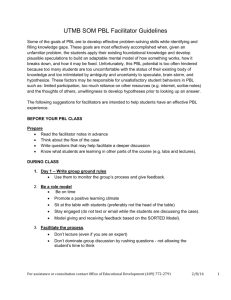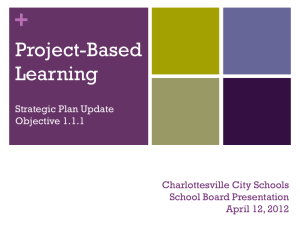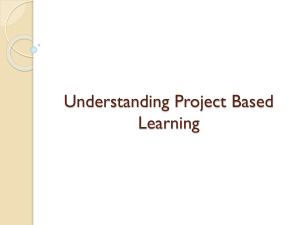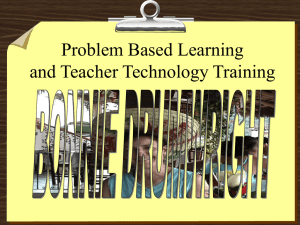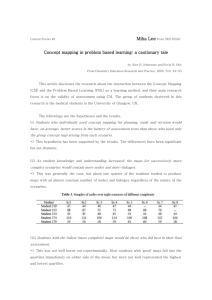Project based learning in distance mode
advertisement
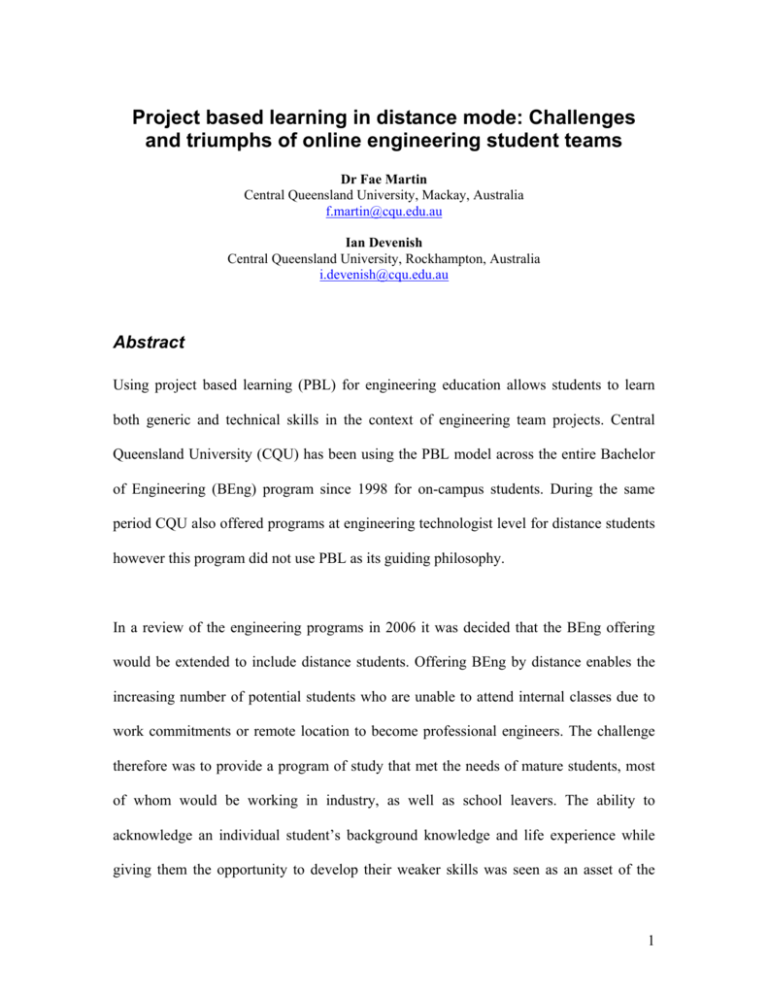
Project based learning in distance mode: Challenges and triumphs of online engineering student teams Dr Fae Martin Central Queensland University, Mackay, Australia f.martin@cqu.edu.au Ian Devenish Central Queensland University, Rockhampton, Australia i.devenish@cqu.edu.au Abstract Using project based learning (PBL) for engineering education allows students to learn both generic and technical skills in the context of engineering team projects. Central Queensland University (CQU) has been using the PBL model across the entire Bachelor of Engineering (BEng) program since 1998 for on-campus students. During the same period CQU also offered programs at engineering technologist level for distance students however this program did not use PBL as its guiding philosophy. In a review of the engineering programs in 2006 it was decided that the BEng offering would be extended to include distance students. Offering BEng by distance enables the increasing number of potential students who are unable to attend internal classes due to work commitments or remote location to become professional engineers. The challenge therefore was to provide a program of study that met the needs of mature students, most of whom would be working in industry, as well as school leavers. The ability to acknowledge an individual student’s background knowledge and life experience while giving them the opportunity to develop their weaker skills was seen as an asset of the 1 PBL approach. However requiring teamwork online would introduce additional complexities. This paper explains the strategies that were used to ensure that all students were given opportunities to meet the learning outcomes of the first PBL course offered in both internal and distance mode. This first trial has been very successful resulting in a high rate of student retention and possible reasons for this success are discussed. Keywords Distance, engineering, external, online, PBL, project, teamwork Introduction Project based learning (PBL) is a learner-centric pedagogy where the learner is expected to take responsibility for their own learning. Students work in teams on projects that provide a context for the learning. The PBL philosophy has been used by Central Queensland University (CQU) as the dominant educational paradigm in the professional Bachelor of Engineering (BEng) program since 1998. However this program was only available to internal students. During the same time period, CQU offered the Bachelor of Engineering Technology (BEngTech) in distance mode. The teaching materials for this program were mailed out to students in hardcopy. Students interacted with their lecturer using email or telephone. The teaching paradigm for the courses in this program was predominantly a traditional approach with students working individually through the provided teaching materials and having minimal interaction with other students in the course. 2 In response to the need for greater flexibility in engineering program offerings, in a review of the engineering programs in 2006 the decision was taken to extend the offering of the BEng to distance mode. The PBL philosophy was seen as an essential component of the BEng and therefore it would be necessary to offer the PBL courses for both internal and external students. This paper will discuss some of the challenges that the offering of a first year PBL engineering course in distance mode provided and also some of the benefits of PBL for distance students. PBL in CQU engineering program In 1993 the CQU Engineering Faculty made the decision to extend the professional engineering program to include industry work placements as an integrated part of the degree. The first offering of the CQU Bachelor of Engineering (Coop) was in 1994 with the first student work placements occurring in 1996. The students going on work placement were at the beginning of their third year of study and early comments from employers indicated they were ill-prepared for the workplace. In fact employers had been saying the same thing about graduate engineers across Australia as was reported in the Changing the culture report released by the peak Australian engineering body Institution of Engineers released in the same year (IEAust, 1996). In response to these concerns research into possible ways of increasing the work readiness of the students was undertaken and PBL was proposed as an educational paradigm that could improve these outcomes. 3 The PBL approach was seen to be especially appropriate as it had been shown that the generic skills such as problem solving, communication and teamwork are well developed by PBL (Wolfs, Howard, Vann and Edwards, 1997). The team projects in PBL have a contextual focus enabling students to understand why they are learning the particular content and how it will be applied in the ‘real world’. The challenges of distance delivery CQU has been offering programs by distance mode since the late 1990’s. However the programs available in this mode have been engineering technology level and did not use the PBL philosophy. The mode of delivery for most of these external courses involved provision of a Course Profile that included details of the course Learning Outcomes and assessment and a hard-copy Study Guide that covered the course content. The student received these materials at the beginning of the term then worked through the material throughout the term according to a schedule outlined in the Course Profile. Generally assessment items were submitted by post at set times during the term. This form of delivery was immediately seen as incompatible with the PBL philosophy. In PBL, students should recognise the need to learn particular content as they work their way through the project. Rather than presenting course material in preparation for assessment, PBL requires the student to identify their own learning needs. Presenting students with a package of learning materials at the beginning of the term is completely at odds with this. A new approach to external delivery was therefore seen as essential. 4 Previous research has shown that the learning experiences of internal and external students are very different. Keegan (1986) lists the major contrasts in the two learning styles including the fact that in face-to-face delivery students may have relatively low internal motivation while distance students are more likely to have high internal motivation. On the other hand, the distance student must communicate through media while the internal student has immediate, personal contact with their teacher. A recent study by Mir and Rahaman (2007) considered the difference in student outcomes between internal and external students for institutions where integrated courses are offered i.e. where both internal and external students study the same course. After gathering data from 6 Australian universities, they suggested that the performance of external students is significantly inferior to internal students studying the same course. One of their recommendations is that more time could be spent in residential schools for external students particularly in their first year. Lawless and Richardson (2002) administered two surveys to large samples of external students of the Open University. One survey focused on whether a particular student was meaning oriented or reproduction oriented in their approach to study. A student who was meaning oriented was characterised by a deep approach to learning, interrelating ideas, relating evidence to conclusions and the ability to think creatively. A reproduction oriented student on the other hand was characterised as having a surface approach to learning, relying on the teaching staff to define learning tasks. The second survey was intended to be an indicator of teaching quality. Questions on this survey related to whether students perceived the assessment and workload were appropriate, if they felt the 5 course helped them develop their generic skills and if the materials and staff support were good. Comparison of the results of the two surveys showed that the meaning oriented students were more satisfied with all aspects of the course (including overall satisfaction) than the reproduction oriented students suggesting that student perception of the quality of their academic experience is influenced by their approach to their learning. One possible inference from this research was that the PBL paradigm, because it encourages students to be meaning oriented and take responsibility for their own learning, might result in better student outcomes for external students than traditional teaching approaches. Engineering Skills 1 learning outcomes and assessment Engineering Skills 1 is the first course in the recommended schedule of study for all students in the professional engineering program and the new engineering technology program and is therefore the first course that most students in these programs study. The learning outcomes for the course are related to professional skills such as communication, teamwork, problem solving and ethics. Assessment for the course is 100% portfolio based (Jorgensen and Howard, 2005). Throughout the term, students work in teams on a succession of mini projects. However these projects do not directly contribute to the summative assessment for the course. Instead they are simply a vehicle for the student learning. At the end of the term, each student submits an individual portfolio detailing how they believe they have met the learning outcomes of the course and including evidence from the projects and workshops they have completed. An important part of the 6 portfolio is the Individual Reflective Journal that each student keeps as a record of their learning during the term. Students participate in four team projects throughout the term. The Design and build project gives students the opportunity to develop their problem-solving skills. Research skills are expanded in History of technology, Disassembly has a focus on materials application and Simulation / modelling develops computer modelling skills. As each project progresses, students are given the opportunity to attend lectures and workshops that are relevant to the project at hand. Offering Engineering Skills 1 for distance students It is assumed that in general, the demographics of external and internal students are very different. In the case of Engineering Skills the internal students are largely school leavers. For the 2007 cohort, the average age of internal students at the start of term was 19.2 years. Compare this to the external students whose average age was 29.8 years. The external students were also widely dispersed geographically with more than 44% residing in areas more than 100km from the internal campuses including more than 8% residing in another state. A typical first year internal student is a full-time student and although they may be employed part-time, their employment is not generally engineering-related. External students however may be apprentices (e.g. drafter, jeweller, electrician), tradespersons (e.g. electrician, fitter machinist), technicians and trainee engineers (mechanical designer, cinema technician, construction foreman, process control technician), sales persons and business owners (earthmoving, bus company). 7 Residential school and team selection In line with the suggestions of Mir and Rahaman (2007), a compulsory one week residential school was scheduled for the first week of the teaching term. This week had traditionally been deemed Induction Week for the internal students and had included various team-building activities such as Ice-breakers and rock-climbing (Martin, Steedman, Smith and Keleher, 2006). A recurring feedback from external students is that they do not feel they are part of the university community. In order to go some way towards addressing this concern, during the first few hours they were on campus the external students attended a welcome lecture with the internal students of the course and participated in the same team-building activities as the internal students. During the residential school, external students were introduced to CQU processes including a session on where to find program/course information and staff contacts on the university website as well as an introduction to the CQU on-line learning management system ‘Blackboard’. However the emphasis during the residential school was on the team activities. Although creating teams consisting of both internal and external students was originally considered, this was dismissed due to the inherent difficulties associated with communication between the two cohorts. The internal students are mainly full-time students and therefore carry out the majority of their teamwork on weekdays. The external students on the other hand are mostly part-time students who work during the day and may study nights or weekends. 8 Team selection for the external students was largely based on postcode making it possible for at least some team members to meet in person once the residential week was over. During the residential week the external teams participated in the rock-climbing activity and had several teamwork sessions. The projects for the internal students are managed in a very linear fashion with students having clearly defined timeframes for each project and completing each project before they move on to the next. During Induction Week all the students work on an introductory fun project but the external students were also given the first of the real projects and encouraged to complete as much of the project as possible. This was partly because the project was hands-on making it more difficult to work on once the team was physically separated. However it had the added benefit of giving the external teams an opportunity to get ahead of the study schedule in case they encountered difficulties later in the term. The time-lines for all the projects were made slightly more flexible for the external students in recognition of the fact that these students need to manage the demands of full-time work and family commitments in addition to their study. Feedback from the reflective journals and course feedback forum showed the external students appreciated the one week residential school at the commencement of the course. The residential school allowed students to work with team members to accelerate the completion of the course projects and provided students with an understanding of their team members’ strengths and weaknesses. 9 Online support Once the residential school was over, the main course resource for the external students was the on-line ‘Blackboard’ course. CQU uses the Blackboard Academic Suite as an eeducation platform for its distance courses. Each week the resources for that week were posted on the website. Internal students attended a one hour lecture each week. These lectures are generally quite interactive with the facilitator asking questions of the students who are then expected to contribute to the discussion. The external students were able to view the slides for the lecture which included the questions that have been asked or they could view the video-stream (including the slides) so that they could see the discussion that took place. All students were asked to reflect in their journal on the content delivered during the lecture. The resource material for the weekly workshops was also posted on the website. However these resources had been designed to be used by the internal facilitator in an environment where additional explanation could be provided verbally and although some resources were redesigned to cater for the external students, more needed to be done in order to clarify what was expected each week. In order to address this issue, a weekly email was sent to the external students outlining the delivered content for that week, where the resources could be found on the website and also reminding them of any approaching deadlines. This had the added benefit of maintaining contact with the students on a regular basis which helped them feel they were a valued member of the cohort even if they were not physically attending class. 10 Blackboard discussion boards were implemented that allowed student interaction with lecturers and other students enrolled in the course. Where students directly emailed a lecturer with a query that would be relevant to other students, either the question / response would be placed on a discussion board or the student would be directed to ask the question on a discussion board. Discussion boards covered the themes of interaction / knowledge of other students, information transfer, team interaction and general course information. Initially, the ability for students to edit their comments was not allowed, however this restriction was lifted after students indicated it was limiting their willingness to contribute if they could not correct errors they had made in their posts. At this time, anonymous posts were allowed, however no students chose to post in this manner. On the interaction discussion board, students were required to post information regarding their work, personal history and aspirations. This allowed students to build on the personal interactions made during induction week. Student feedback indicated this discussion board was useful in reminding students of team member skills and helping to build a stronger team understanding. The information transfer discussion boards related to specific topics covered during the course. While course content was provided via Blackboard through other channels, these discussion boards provided students with a forum to ask either general course questions or those on a specific topic e.g. MATLAB or AutoCAD. Students were encouraged to 11 respond to questions from other students on these boards, especially in the specific topic forums where it was recognised that because of the work history of the students some already possessed the skills in these specific areas. Team interaction discussion boards and file exchange areas were provided that were available only to members of the team. These were the most used areas of the discussion board allowing students to work together on their team projects. General course information discussion boards provided a forum where students could ask questions relating to course procedure and provide feedback on the course. Students were made aware that anonymous posts were allowed on these boards, however no students posted anonymously. On all the discussion boards, students were made aware of the amount of feedback or monitoring the board would be subject to. General discussion boards were monitored and responded to on a daily basis, while the team discussion boards were monitored but had minimal lecturer input. Audio-visual presentations One facet of the communication learning outcome that is particularly challenging in distance mode is audio-visual presentation. Internal students are able to achieve this outcome by presenting the outcomes of their project work in class. For the external students this was managed by having the teams provide information before the presentation date, and then using conference telephone calls to present and support their 12 data. Similarly conference calls were at times initiated by the student teams where verbal interaction was deemed necessary by them. Results for external and internal cohorts Retention rates for Engineering Skills 1 have traditionally been quite high but of course there had previously only been internal students in the course. Data from 2005 and 2006 shows that more than 85% of students who enrolled in Engineering Skills 1 continued into the second term PBL course (Martin, Steedman, Smith and Keleher, 2006). However the difficulties of studying externally have historically resulted in high attrition rates for distance students. An analysis of the 2007 enrolment data for Engineering Skills 1 showed that 93% of internal students and 85% of external students enrolled in the subsequent course. These results are consistent with the internal attrition rates in previous years. It is believed that team peer pressure and the desire not to let the team down contributed to the retention during the term. This conclusion was reinforced by anecdotal evidence from teams. Comparison of results for the two cohorts is shown in Figure 1. Note that the students designated as failing include those who were still enrolled several weeks into the term but who later chose not to complete the course. These results show that the grades achieved by the external students were comparable with the internal students so it seems that the external students were not disadvantaged by the mode of study. 13 Grades for external and internal students % of students 50 40 External 30 Internal 20 Total 10 0 HD D C P F Grade Figure 1. Grades for external and internal students 2007 The student grades for this course as well as the high retention rates and anecdotal evidence of high student satisfaction with the course indicate that the PBL philosophy is well suited to external delivery. It is not clear whether this is because PBL supports the development of independent, meaning oriented students (Lawless and Richardson, 2002) or whether it is because of the increased peer support that developed as a result of the team projects. However in either case, the student outcomes were very encouraging. Conclusion From the outset it was realised that offering a PBL course such as Engineering Skills 1 for distance students would require different teaching and learning strategies to those that were employed for internal students. Ultimately both cohorts of students needed to be given learning opportunities that would enable them to demonstrate they had met the learning outcomes of the course. However it was recognised that these learning opportunities did not have to be identical provided the outcomes were the same. The 14 open-ended format of the PBL pedagogy and portfolio assessment proved to be assets when trying to cater for the two quite different cohorts. Even the teamwork requirements which were initially expected to be challenging for the external students eventually proved to have very positive consequences as the students formed strong team bonds that encouraged them to keep going when they were experiencing difficulties. It should be noted that although the teams were kept the same throughout Engineering Skills 1 for the subsequent PBL course the student teams were changed around based on results and postcode. Students have only just completed the follow-on course and at the time of writing the grades have not been finalised. However preliminary anecdotal evidence seems to suggest that this follow-on course has also been successful in terms of student outcomes. References IEAust (1996). Changing the Culture: Engineering Education into the Future. Institution of Engineers, Australia, Canberra, Australia. Jorgensen, D & Howard, P (2005). Assessment for Practice Oriented Education. In WACE 2005 Conference Proceedings (732111). Boston: World Association for Cooperative Education. Keegan, D. (1986). The foundation of distance education. London: Croom Helm. 15 Lawless, C. & Richardson, J. (2002). Approaches to studying and perceptions of academic quality in distance education. Higher Education, 44, 257-282. Martin, F., Steedman, M., Smith, K. & Keleher, P. (2006, December). The Importance of Induction and Orientation Activities for First Year Engineering Students. Paper presented at 17th Annual Conference of the Australasian Association for Engineering Education, Auckland, New Zealand. Mir, M. Z. & Rahaman, A. S. (2007). Off the radar: The problem of distance-learning in ‘integrated’ degrees. Australian Universities Review, vol 49, No 1 & 2, pp. 39-47. Wolfs P. J., Howard, P., Vann, A. & Edwards, R. (1997). A response to the National Engineering Education Review, BE2001 - A project engineering degree. In Proceedings of the Third Bi-annual Conference of the Australian Problem Based Learning Network (pp. 674-681). Newcastle, New South Wales. 16




